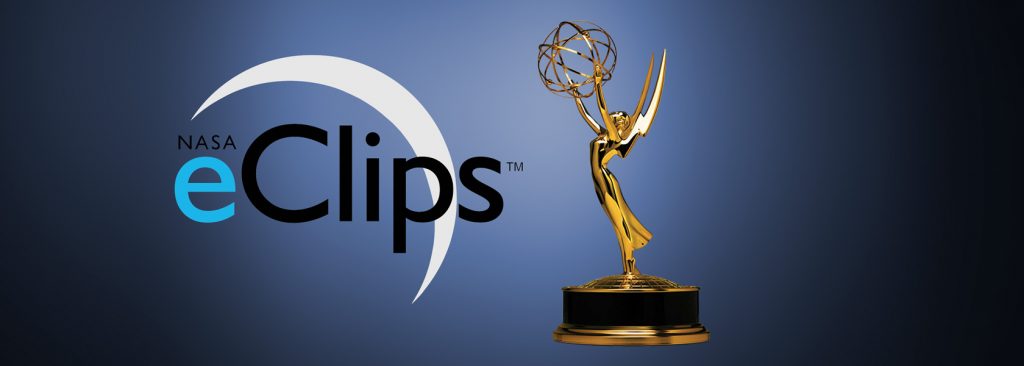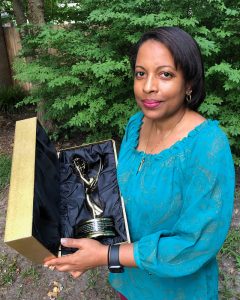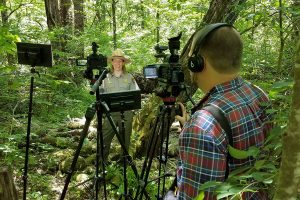
NASA eClips Team Awarded Emmy
When you get an Emmy award in the mail, it’s different from any package you’ve likely ever opened before. The box itself has sleek gold foil–and feels a little heavier than it should for its size. Like the custom-molded seats on NASA’s latest spaceship, the precise form of the black satin-covered foam inside cradles the shiny gold statuette, protecting its precious cargo during its journey home. The box that holds an Emmy award is built to such exacting standards that when you first open it, you feel a slight suction as the lid separates from the base. So, while giving your acceptance speech for an Emmy award during a virtual ceremony can’t be the same as delivering that speech under hot stage lights in front of hundreds of your peers, there’s still a visceral thrill that comes with receiving the most prestigious award the television industry can give.
On Aug. 8, the National Institute of Aerospace (NIA) won an Emmy Award from the National Capital Chesapeake Bay Chapter of the National Academy of Television Arts & Science (NATAS) for the NASA eClips series. To protect the health of NATAS chapter members representing the Maryland, Virginia, andWashington D.C. television communities, the 62ndEmmy Awards Gala was held online. This is why those famous gold statuettes were shipped to the winners, including the NASA eClips team.
“Carbon, Essential for Life on Earth, Explained by NASA Subject Matter Experts” featured two videos representing the NASA eClips series, which won in the Informational/Instructional – Feature/Segment/Series category. NIA produces the program through a cooperative agreement with NASA’s Science Mission Directorate.
 In the first video, students meet Dr. Lola Fatoyinbo Agueh, one of the program’s featured NASA Subject Matter Experts (SMEs). It’s clear that Dr. Fatoyinbo Agueh, who is based at NASA’s Goddard Space Flight Center, has a genuine excitement for discovering new things. As students watch Dr. Fatoyinbo Agueh explore the world’s forests and swamps on field missions, they learn about her journey to become a research physical scientist. They see how she uses satellite imagery in her research. Many also begin to imagine themselves in a STEM career.
In the first video, students meet Dr. Lola Fatoyinbo Agueh, one of the program’s featured NASA Subject Matter Experts (SMEs). It’s clear that Dr. Fatoyinbo Agueh, who is based at NASA’s Goddard Space Flight Center, has a genuine excitement for discovering new things. As students watch Dr. Fatoyinbo Agueh explore the world’s forests and swamps on field missions, they learn about her journey to become a research physical scientist. They see how she uses satellite imagery in her research. Many also begin to imagine themselves in a STEM career.
 Dr. Paul Montesano, another research scientist from NASA’s Goddard Space Center, joins Dr. Fatoyinbo Agueh in the second video. “Real World: The Carbon Cycle — Essential for Life on Earth,” which is aimed primarily toward middle school students. A teenage host named Mishay asks both NASA researchers questions. The experts deftly explainthe carbon cycle and examine the role mathematics plays in how that life-sustaining element moves through the environment. “We look for subject matter experts who are passionate about their work and excited to share with the public what they do, why it is important and the impact that it has,” says Sharon Bowers, an executive producer of the series and senior STEM education specialist at NIA. Bowers, who holds a doctorate in Integrative STEM Education, has over 30 years of experience as a classroom educator. She and her colleagues have refined NASA eClips’ videos and their corresponding interactive lessons based upon research-based best practices.
Dr. Paul Montesano, another research scientist from NASA’s Goddard Space Center, joins Dr. Fatoyinbo Agueh in the second video. “Real World: The Carbon Cycle — Essential for Life on Earth,” which is aimed primarily toward middle school students. A teenage host named Mishay asks both NASA researchers questions. The experts deftly explainthe carbon cycle and examine the role mathematics plays in how that life-sustaining element moves through the environment. “We look for subject matter experts who are passionate about their work and excited to share with the public what they do, why it is important and the impact that it has,” says Sharon Bowers, an executive producer of the series and senior STEM education specialist at NIA. Bowers, who holds a doctorate in Integrative STEM Education, has over 30 years of experience as a classroom educator. She and her colleagues have refined NASA eClips’ videos and their corresponding interactive lessons based upon research-based best practices.
NASA eClips’ STEM education specialists have all been classroom teachers. They are adamant about connecting with students and educators in classrooms regularly. “We use intentional design as part of the development process to create resources that capture students’ attention and encourage participation in STEM activities,” says Joan Harper-Neely, who joined the NASA eClips team in 2016. Harper-Neely serves as another executive producer for the series. She spends most of her days leading workshops that show other educators how to use hands-on project-based activities and lessons to teach math and science content that is relevant, engaging, and authentic. Harper-Neely adds, “Introducing science concepts and NASA technologies through this program inspires and empowers learners to help bring STEM literacy to all students.”
To learn more about NASA eClips videos and resources, visit: https://nasaeclips.arc.nasa.gov.
Watch “Ask SME: Dr. Lola Fatoyinbo Agueh – Research Physical Scientist”at: https://nasaeclips.arc.nasa.gov/videosingular/asksme/research-physical-scientist-dr-lola-fatoyinbo-agueh.
See “Real World: The Carbon Cycle – Essential for Life on Earth”at: https://nasaeclips.arc.nasa.gov/video/realworld/real-world-the-carbon-cycle-essential-for-life-on-earth.
“Our goal is to make it super easy for teachers to complement their instructional goals using these engaging and standards-based materials,” notes Shelley Spears, who serves as the program’s principal investigator. “These videos and resources are all easy to access and completely free for teachers and the public.”

Access to standards-based educator resources that are linkable and downloadable has become even more critical as school districts move toward virtual learning tools in efforts to protect their students’ and teachers’ health. Shannon Verstynen, program manager and co-principal investigator notes, “Since the NASA eClips series launched in 2008, our team has built a library of approximately 200 videos and related educational resources.” Aimed at grades 3-5, 6-8, and 9-12, those materials include interactive lessons available through popular educational platforms, such as Nearpod and ClassFlow–is selected based on national curriculum standards. A Teacher Advisory Board reviews all new products to make sure they meet standards, including the Common Core State Standards – Mathematics (CCSS-M), the Next Generation Science Standards (NGSS), the Standards for Technological Literacy (defined by the International Technology Engineering Education Association [ITEEA], and the International Society for Technology in Education [ISTE]).
NASA eClips won a prior Emmy award in 2009 and was nominated again in 2012. Since NIA’s founding in 2002, their media production team has won a number of Emmy awards for other television shows they produce for NASA, including the popular NASA 360 series. But, this is the first Emmy statuette to reach the hands of several members of the current NASA eClips production team, including producers Seth Robinson and Caleb Stern.
“Because schools use NASA eClips videos, we have to hit certain standards that educators expect us to cover,” says Stern. “Part of the fun is finding ways to incorporate the amazing information from our NASA experts in a way that appeals to kids, but also checks all those boxes for the educational standards.” Robinson adds, “We figure out how to explain the material in a way that makes a third grader or a sixth grader remember it, or at least start a conversation with their parents or teacher.” “Caleb and I are both fairly new dads, so writing these scripts really gives us a chance to practice our ‘dad jokes’ and helps make the episodes fun to watch.”

Stern and Robinson both hold Bachelor of Science degrees (in mechanical engineering and film production, respectively), and Stern earned a Master of Fine Arts in film and television directing.That educational background serves the team wellas they convey fundamental math and science concepts through a mix of video, animation, and insightful explanations in each episode. Education specialists also attend the video interviews with the NASA experts and provide input and feedback throughout the production process.
Teamwork between the media team members at NIA is central toward keeping their rapid production schedule on track. Stern rattles off a list of half a dozen names that helped shape the interview questions and supported him and Robinson to create the award-winning videos. “We often find ourselves collaborating with each other by phone while we are on the road in different parts of the country to get these done,” remarks Stern. Robinson completes Stern’s train of thought as effortlessly as taking a baton handoff in a practiced relay race. “It’s nice because we can easily switch and blend our roles as directors and editors, because we share that interest in both the technical and creative.”
With that spirit of collaboration at the forefront, this diverse crew of educators and media specialists come together to produce NASA eClips with meticulous production and educational standards–standards that befit not only the gold statuette that is an Emmy award but also the box that holds it.
